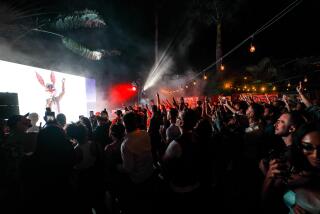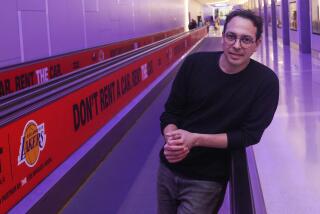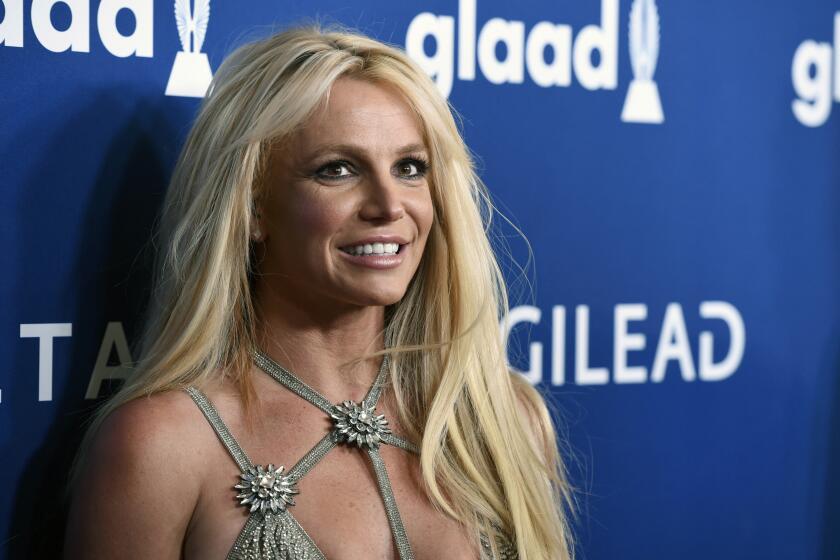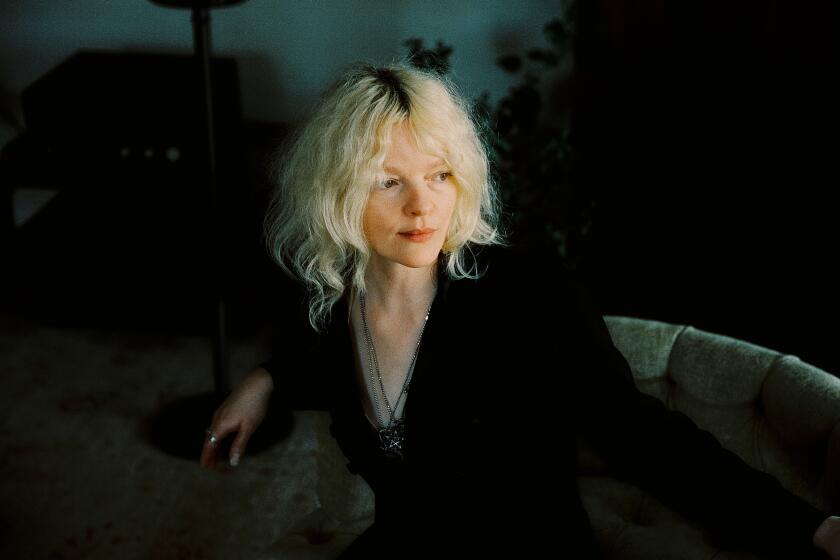V Squared Labs visualizes dance music
When Brazilian electronic musician Amon Tobin took the stage at the Greek Theatre for his headlining set in October, fans couldn’t see much of him. That’s because he was concealed behind panes of opaque, electrically charged specialty glass, part of an enormous Cubist lighting contraption that filled the stage.
From a booth in the crowd, technicians projection-mapped images onto the milky blocks, turning the stage into a color montage cued to the music, punctuated with images of space travel (fitting, as Tobin was wearing a full-body astronaut suit).
FOR THE RECORD:
V Squared Labs: A Dec. 30 article about the digital design firm V Squared Labs should have said that Heather Shaw and her firm Vita Motus collaborated with V Squared Labs on design work in the stage sets of Amon Tobin and “American Idol,” among others.
The project, ISAM 2.0, is part of Tobin’s ongoing experiment in disappearing into a live setup and using visuals to enrich the music’s story rather than just performing songs.
Best of 2012: Movies | TV | Pop music | Jazz | Video Games| Art | Theater | Dance | Classical music
He’s not alone in that vision for how electronic music can command a stage.
L.A. company V Squared Labs collaborated with Tobin on the show, designing the physical and digital architecture of the visuals and integrating it with his live mixing. Beyond Tobin, the company just retrofitted the new EDM-heavy Hollywood club Sound and has done similar setups for electronica acts and events such as Skrillex, the Electric Daisy Carnival in Las Vegas, Hard events and the dance-heavy Sahara Tent at the annual Coachella festival in Indio. In essence, V Squared — a small outfit with a staff of nine — is creating the future of live shows in an era where music is made and played on software.
“He didn’t want to be standing in the front of the stage,” V Squared founder and designer Vello Virkhaus said of Tobin and his set. “He wanted to be a part of it. He became the stage.”
Virkhaus founded the firm in 2000, just after electronic acts such as the Prodigy and Moby began to make inroads in American pop culture. At that time, major rock bands such as U2 had long enjoyed elaborate lighting and pyrotechnics for their sets. But in America at least, DJ culture was mostly confined to indoor nightclubs or festival stages where a projection screen and some lasers would set the mood for an artist. The focus was generally on watching your dance partner — not the stage.
That began to change in the mid- to late 2000s, when dance sounds began colonizing radio and DJ-centric festivals such as Electric Daisy and Hard, along with Coachella, drawing tens (and sometimes hundreds) of thousands of fans. Daft Punk’s lauded 2006 performance at Coachella, which featured a monolithic light pyramid, raised the stakes for live electronica visuals seemingly overnight. Now, even DJs had to plan for stage setups like an arena-rock band.
Today, other companies such as StarLight Visual and SJ Lighting are also designing sets to make EDM shows more lively. “Competition is a way to evolve,” Virkhaus said. “EDM expanding into more immersive territory was necessary. It’s becoming more like Cirque du Soleil than a rock show today.”
At the same time, the software used to make electronic music and visuals began converging toward a price point and technical capability that gave electronica artists greater access and possibilities. Virkhaus, a lifelong dance music fan, was one of the first to capitalize on the possibilities of what a digitally savvy stage designer could do in an EDM setting. With the musical “performance” generally confined to an artist manipulating software, almost anything could be happening around them.
ISAM “is a deliberate statement about my role as a music producer as opposed to a performer onstage,” Tobin said. “There’s often a wide gap between making something aesthetically consistent with what you actually do and playing the role of a rock star. I’m happy to play that role, but the challenge with this show was to build a compelling live format for music that has really nothing to do with performance.”
Although V Squared Labs has built more traditional setups for rock acts such as Red Hot Chili Peppers and Coldplay and the “American Idol” sets, the dance space is where the company shines. It often creates projects, such as Tobin’s, by designing a “virtual object” in software and crafting visuals around it. Then the company builds a scaled live installation to match it and projects the results (cued to certain musical patterns) in ways that make it look as if the stage is alive.
The results vary as widely as the artists V Squared Labs works with. Its Electric Daisy and Coachella installations are seas of lights interacting with artists’ mixes. The challenge at such festivals is in visually entertaining tens of thousands of fans while also giving an identity to a rotating cast of artists.
“If you’re at EDC without a video screen, the average punter couldn’t tell the difference between half the artists up there,” Virkhaus said. “The lights, the video and the sound are an inseparable part of the enjoyment. But I think the overall essence can eclipse that of a guitarist doing a solo.”
As dance music and EDM festivals increasingly become a permanent part of American musical life, their integration with high-end visuals is opening entirely new avenues for artists to express a vision — and for venues to create immersive spaces for that vision. You’re not watching a performer, you’re watching a visual embodiment of the music — and that might be one way to make sure an artist in a fast-moving scene doesn’t disappear so quickly.
“I think the real achievement of the show was that it successfully presented music that is quite specialized and unusual to a wide range of people,” Tobin said. “We found a way to sell out venues all over the world without selling out what’s at the heart of the performance.”
PHOTOS AND MORE
PHOTOS: Iconic rock guitars and their owners
The Envelope: Awards Insider
PHOTOS: Grammy top nominees
More to Read
The biggest entertainment stories
Get our big stories about Hollywood, film, television, music, arts, culture and more right in your inbox as soon as they publish.
You may occasionally receive promotional content from the Los Angeles Times.







